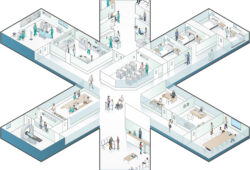The Pros and Cons of Ultraviolet Light Disinfection
One out of every 25 hospital patients will contract a hospital-acquired infection (HAI) during their stay, according to data from the Centers for Disease Control and Prevention. These infections may result in severe health problems or require readmissions that drive up healthcare costs.
While healthcare facilities have detailed processes in place for disinfecting rooms, the persistence of HAIs suggests there are opportunities to do more. Medical device manufacturers have introduced deep ultraviolet (UV) light-emitting diodes (LEDs), which use short-wavelength ultraviolet (UV-C) light to disinfect operating rooms and other areas to prevent the spread of HAIs.
These systems are intended to be more energy-efficient and portable than the germicidal UV systems being used by many hospitals today.
How It Works
UV disinfection aims to stop the spread of staphylococcus aureus (or staph), methicillin-resistant staphylococcus aureus, Clostridium difficile (C-diff) and other pathogens by disrupting the DNA of harmful microorganisms so they are unable to reproduce. The C-diff spore can remain active on surfaces for up to three months and is the most difficult to kill, but studies show that UV light can be effective in eliminating it.
In 2014, three hematology-oncology units at the Hospital of the University of Pennsylvania participated in a 12-month study to determine the effectiveness of UV light disinfection in preventing hospital-borne infections. The study results were published in Infection Control & Hospital Epidemiology, the journal of the Society for Healthcare Epidemiology of America, and showed that when UV light disinfection was used to clean unoccupied patient rooms, the high-risk patients who later occupied those rooms were significantly less likely to contract C-diff.
In the study, the hospital added UV disinfection to its disinfection protocols in three units. After a typical room cleaning, the hospital’s environmental services team would utilize an ultraviolet robot to further disinfect the room—reducing the incidence of C-diff infection by 25 percent among new patients in those units. Over the same yearlong period, the C-diff infection rate increased 16 percent in the non-study units.
In another study, published in the June 2014 American Journal of Infection Control, researchers at Westchester Medical Center in Valhalla, New York, observed a 17 percent reduction in hospital-acquired C-diff with the addition of UV light disinfection following standard terminal cleaning of high-risk patient rooms.
These studies show that UV light disinfection is a promising strategy in the fight against HAIs. But potential doesn’t mean proven, which is why many healthcare organizations are still reluctant to incorporate the technology into their facilities.
“The process is increasingly being used, but it’s not commonplace,” says Ed Septimus, M.D., medical director of infection prevention and epidemiology, HCA Clinical Services Group.
Some Tenet Health facilities are using the approach, but only sporadically, says Nicholaos Bellos, M.D., assistant vice president of medical operations at Tenet Health in Dallas. “We haven’t collected any data yet, so we’re not ready to make a definitive decision about whether to use it across the board,” he says.
Considering Challenges
Another reason for moving slowly to implement UV disinfection is that the equipment is expensive, Bellos says. Also, it “requires manpower to move the UV system around the room as it cleans, and staff education to get it started,” he adds. An additional sticking point is the lengthier cleaning process. “We’re finding that using the UV disinfection equipment adds 30 to 45 minutes to cleaning,” Bellos says. The researchers at Westchester Medical Center found it added 25 minutes to the cleaning process. According to the Pennsylvania study, room cleaning with UV disinfection took only five minutes longer on average. In actual practice, cleaning times vary from one hospital to the next because every facility has its own cleaning protocols.
In addition, it’s difficult to pinpoint what’s causing the spread of C-diff or other spore-borne illnesses in any given hospital.
“Multiple factors contribute to C-diff rates, including disinfection of the room, antibiotic use, infection prevention and patient population,” Septimus says. “So the effectiveness of UV disinfection depends on the facility; some have seen a reduction [in infections] and others have not.”
Weighing the Decision
Despite its promise, there is no evidence supporting UV disinfection as a stand-alone method for disinfecting a patient room. It should be used only after standard cleaning and chemical disinfecting processes have been employed. Becoming proficient in basic infection prevention practices, such as hand hygiene for healthcare workers, barrier and contact precautions, equipment management, antimicrobial stewardship and active surveillance, can play a much larger role in the prevention of HAIs.
Trinity Health is switching to a sporicidal disinfectant for all rooms, and focusing on standardizing and validating the cleaning and disinfection processes, says Meredith Hotchkiss, regional manager of hospitality services for Trinity’s western region. Eventually, the hospital group may utilize UV disinfection “as a supplementary intervention,” she adds. “However, this should be a data-driven decision-making process.” In outbreak cases where root-cause analysis points to environmental factors, UV disinfection may be considered.
“The first step is to ensure all basic practices are being consistently applied,” Septimus says. “Jumping to technology without making sure these basic practices are being executed will only result in small changes.”
Share Email HAI, Hospital Acquired Infections, Q1 2017, UV light





